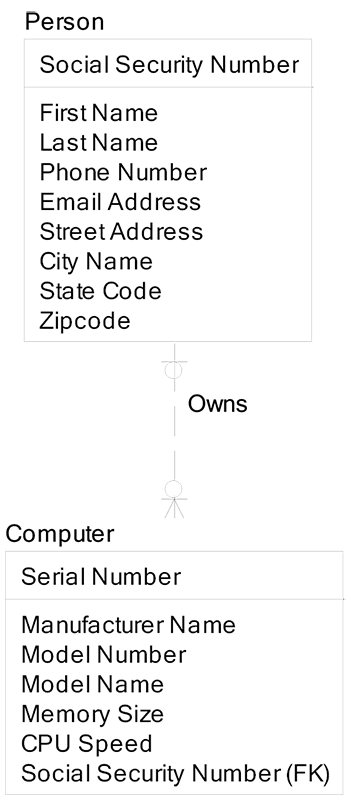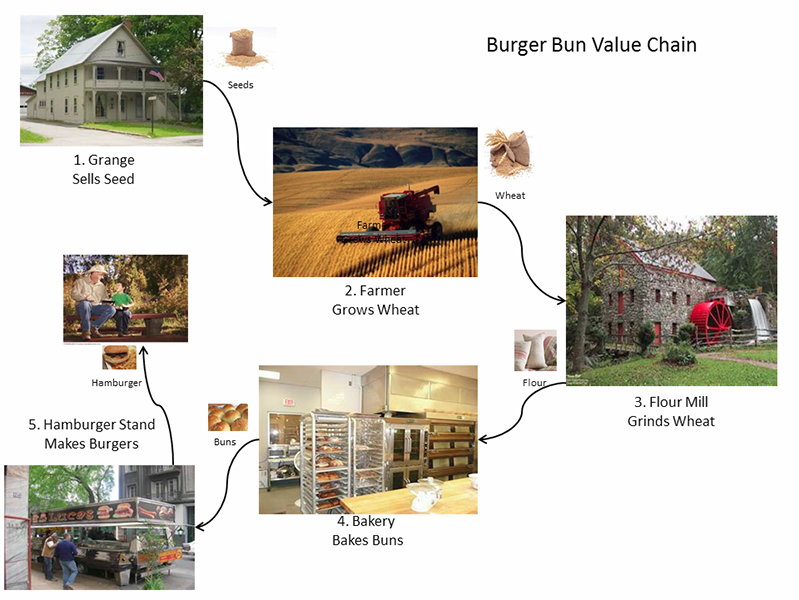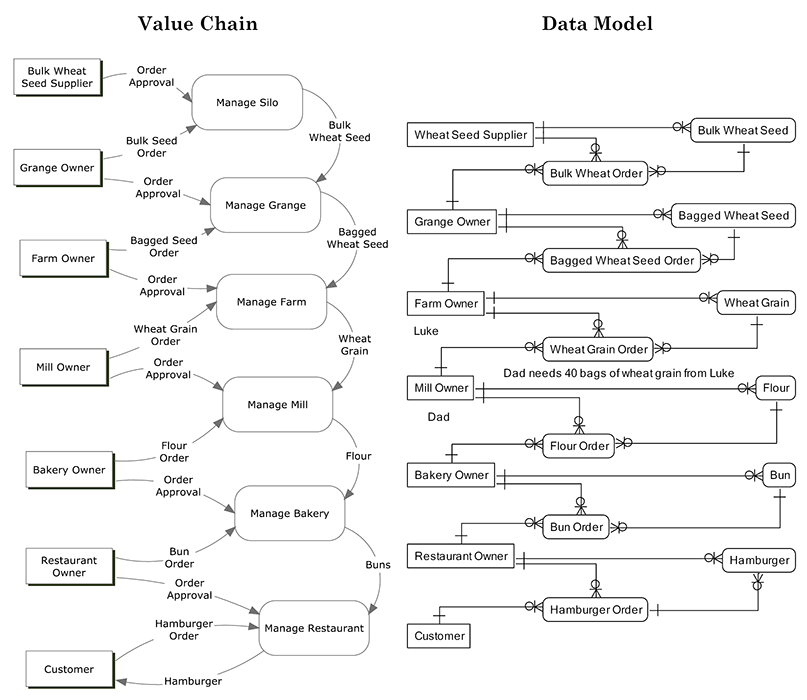
Value Chain and Data Model States
Each value chain has a design that represents the structure, the plan, and the hopes for the value chain. This design will be documented in Product and Service Master Data, which we will discuss in detail later. As the value chain executes through actions and transactions, the design becomes manifest in the real world. Value chain execution requires business process instructions for both the people in the business and the machines (software instructions). These actions and transactions have a data model corollary called transactional data, which we will discuss later. These actions and transactions generate a historical record of instances of the value chain lifecycle. Real world value chain actions and transactions can vary from their design due to real world complexity and exceptions not anticipated in the value chain design.
Lastly, the measurement of value chain transactions requires us to have a metrics generation process that captures master and transactional data and then transforms them into a schema that allows us to measure the value chain. These metrics show where strengths and weaknesses exist in the business and provide feedback on the wisdom of your business models, value chains, and data models.
- The benefits of the value chain design are greatly enhanced when the value chain design is stored on a computer. Value chain designs stored on a computer can:
- Run simulations to guide the business owner as to the profitability and risks associated with proposed alternative approaches to the current value chains (called business simulation)
- Take business volume forecasts and drive the scheduling and ordering of resources required to meet these volumes (called enterprise resource planning)
- Inform and train all participants as to the roles and positions they play in delivering value to the end customer
- Train employees and partners
- Calculate performance bonuses for value chain leaders
Luke asked several questions that proved I was failing to be clear. Also, he had been squirming around in his chair and looking out the window, so I tried a new approach. Luke and I had recently toured the Boeing airplane factory near my house. He was totally engrossed with the process and the potential outcome (flying to Hawaii). I shifted my presentation from professorial axioms that bolstered my already overinflated confidence to present a single concrete example from our tour of Boeing. Designing and building airplanes involves the engineering value chain. We start with designs, build instances of designs, and then measure the instances to see if they match the designs within our tolerances.

In data modeling, the master data for products and services represents the designs of the things the business will deliver to customers. The actual constructed engine represents the execution of the design for the engine. In data modeling, transactional data will represent the execution of our designs. The measurement state of the engine is represented by the testing and quality assurance of the engine. Installing instruments to measure vibration, thrust, and pollutants is the measurement state of the engine. If some engines are generating insufficient thrust, the design of the engines will need to be changed. New engines must be built and the thrust re-measured. In data modeling, our measurement will appear in dimensional modeling, which will drive our reporting data warehouse.
Value Chain Components
All value chains are represented by four simple components:
- External Actors (rectangle)
- Input Flows (arrow coming into a process)
- Processes (box with rounded corners)
- Output Flows (arrow coming out of a process)
The diagram on the facing page is a simple value chain represented by a data flow diagram. Further, these components can be nested within themselves to decompose the value chain into more and more detailed descriptions of process and data flows between processes.

Data Model Components
All data models are represented using three simple components:
- Entities and Relationships (boxes are the nouns and lines are the verbs)
- Uniqueness Constraints (primary key and alternate keys)
- Attributes (properties for each box)

I told Luke that the clarity, consistency, and universal applicability of value chain and data model thinking will drive thousands of dollars into his pocket—if he can learn these simple and powerful ideas. Again Luke was listening—looking, leaning forward, and almost tasting the monetary fruits that could come from his impending lemon business.
He asked how much Uncle Bill made last season, and I replied, “About $4,700 of profit. But Uncle Bill had disease in many of the trees last year. Uncle Bill sprayed late last September, and this year every tree should be more productive.” With curiosity in his eyes, Luke asked “Tell me more about this value chain thing.”
Value chain is a sequence of activities that produce a series of results that eventually lead to the delivery of finished goods to the customer, resulting in profits for your pocket. This linkage of “processes/activities” and “artifacts/results” is specifically designed to allow for specialization in the division of labor and to articulate the artifacts or things that flow between specializations.
Each activity represents a specific skill required to deliver the finished goods. Each skill takes some input artifacts having small value and then executes the skill of the specialization, delivering output artifacts containing greater value. For example, if my specialization is to be a farmer of wheat, and your specialization is to be a grinder of wheat to produce flour, then my value chain output of “wheat” is your value chain input.
The artifacts in the value chain will be defined in a data model, and this data model will drive the structure and contents of your computing system database. The structure and contents of your computing system database are the limiting factor for the set of capabilities the system can deliver to its users, so your database foundation has to be right.
Key Points
- To increase our odds of being successful in business and information technology, we need to think of the world as consisting of:
- Designs: The ideas that describe what we hope to build or deliver (Master Data).
- Execution: The manifestation of our designs into real world deliverables (Transactional Data).
- Measurement: The metrics that tell us if our real world deliverables live up to our designs, and if our customers are getting value from our deliverables (Business Intelligence Data).
- It is critical that the pattern of things and their relationships for the real world business and the patterns in the computer system are aligned.
- These similarities are easier to achieve when you use value chain and data models as your method of thinking, communicating, and interacting with computing systems.
The Burger Bun Conceptual Value Chain and Data Model
Luke had lapsed back into fidgeting, complaining, and looking out the window. The biggest complaint was hunger, which was reasonable considering we were two hours late getting lunch. Luke loves the local hamburger stand, so we went there for lunch. I got a drab salad, conforming to my new diet, and Luke had two mini-burgers and a milkshake.
When we returned, I tried the Boeing trick of moving my teaching style from philosophical to a more tangible, real, and high priority subject like…burgers. “Luke, let’s take an example value chain and call it the ‘Burger Bun Value Chain.’” Luke, however, was stuffed with fat and protein. He was sleepy and had lost interest in the burger topic. Next time, I vowed to present this value chain example to hungry, awake students, but for now I forced Luke to listen. Below are some specializations in this value chain:
- Granger: A business that sells bags of wheat seed
- Farmer: A business that plants seeds to grow wheat
- Miller: A business that grinds wheat to make flour
- Baker: A business that uses flour to make buns
- Burger Stand: A portable business that uses buns to make hamburgers

Each specialization in the burger bun value chain performs a set of activities. They each take artifacts from upstream, apply their unique skill to convert them into new and more valuable artifacts, and then pass them downstream in the value chain. At this point Luke jumped in to ask why we were not talking about lemons. He was sad to hear that he would learn the principles of business before he would learn to apply them with his unique and memorable style of trial and error.
Value chain involves many “things,” or “artifacts,” that are referred to by nouns in our language. The data model will specify those “things” that play a critical role in each value chain so that we can speak and think clearly about them and understand the relationships between them. Following is a diagram of the ordering and delivery of products part of a simple hamburger bun value chain, along with its related data model. Marketing, sales, contracts, billing, and payments are not covered.
The facing page contains two diagrams. This value chain model is expressed as a Data Flow Diagram, or DFD. The DFD shows how input entities are converted to become output entities, and it shows how different external actors can interact. For example, Luke wanted to play the role of a farm owner, and he wanted me to be the mill owner. In the DFD below, the mill owner, Dad, places an order for 40 bags of wheat grain with the farm owner, Luke. Luke checks Dad’s credit rating and payment history and decides that I am a low-risk customer. He approves my order for 40 bags of wheat grain. Inside of Luke’s process called “Manage Farm,” Luke bags up 40 bags of wheat grain, puts them on a truck, and delivers them to my milling facility. This is the arrow on the right side of the DFD going between “Manage Farm” and “Manage Mill.” The arrow is labeled “Wheat Grain” which, in this instance, represents 40 bags of wheat grain flowing from the farm to the mill.
Trudy, our neighbor and best friend, walked in for the last part of our discussion and looked perplexed. I asked Luke to summarize our lesson to test his grasp of the value chain topic. Luke told Trudy that things with a small amount of value, like a stalk of wheat, can be turned into things with a large amount of value, like a hamburger bun, by moving these things through the steps of a value chain. The value chain is a collection of specialists who collaborate to deliver value to a customer. Trudy and I raised our eyebrows and crooked our heads in approval and disbelief. Luke got it completely!
Next to the value chain model on the facing page is a conceptual data model of the things of interest to the business owners of the Hamburger Bun Value Chain. For example, if Luke is the owner of a farm and I am the owner of a mill, the CDM shows how my things are related to Luke’s things. Luke’s farm gets an order for wheat grain from dad’s mill.

Key Points
- Humans dominate the earth partially because our brains, cultures, and information systems facilitate collaboration between specializations called value chains.
- Collaborations between specializations can be chained together into larger and larger webs, resulting in prosperity for all participants.
- Human value chains can span the planet. They can merge and split to form optimal configurations, given environmental demands.
